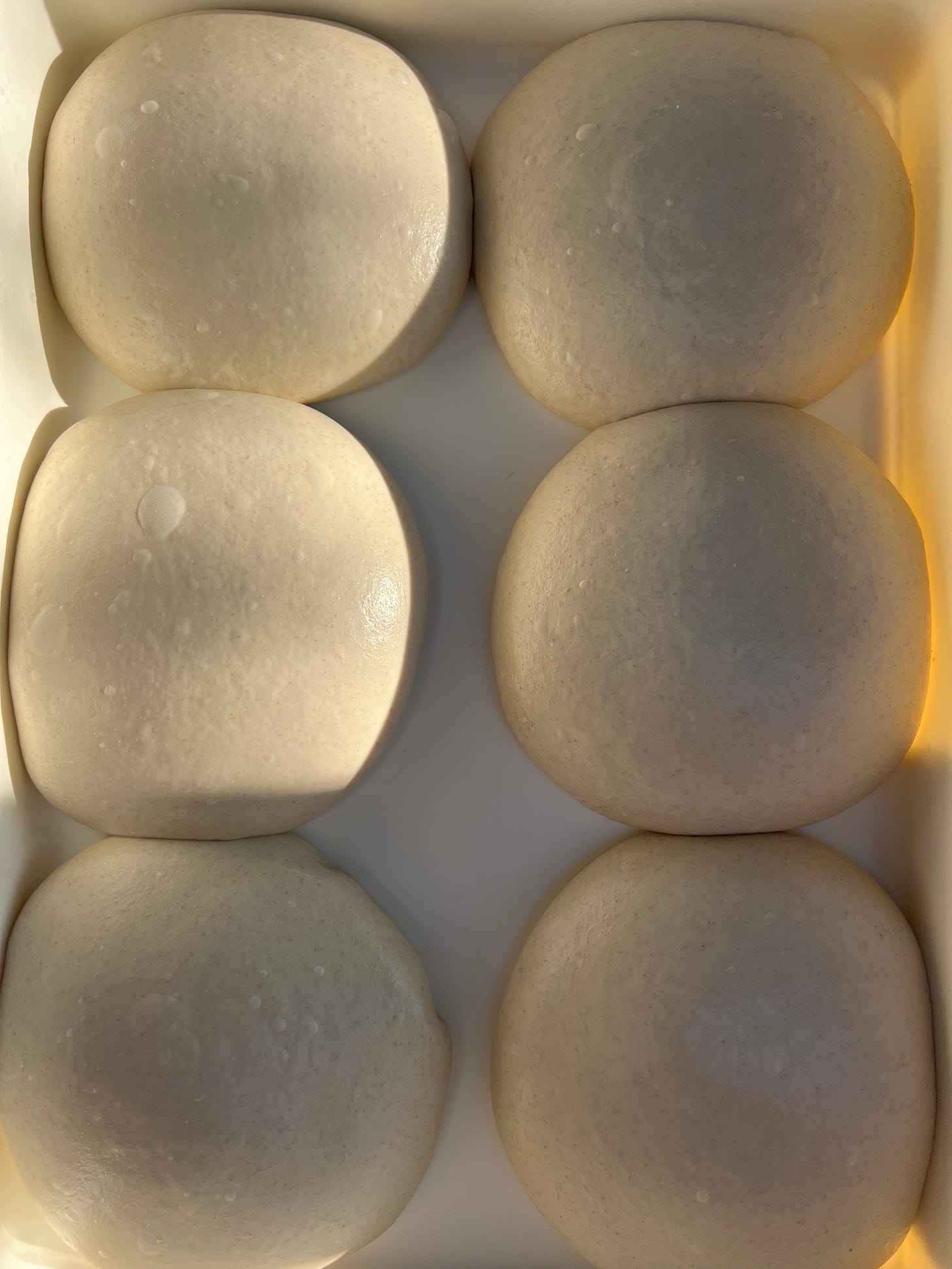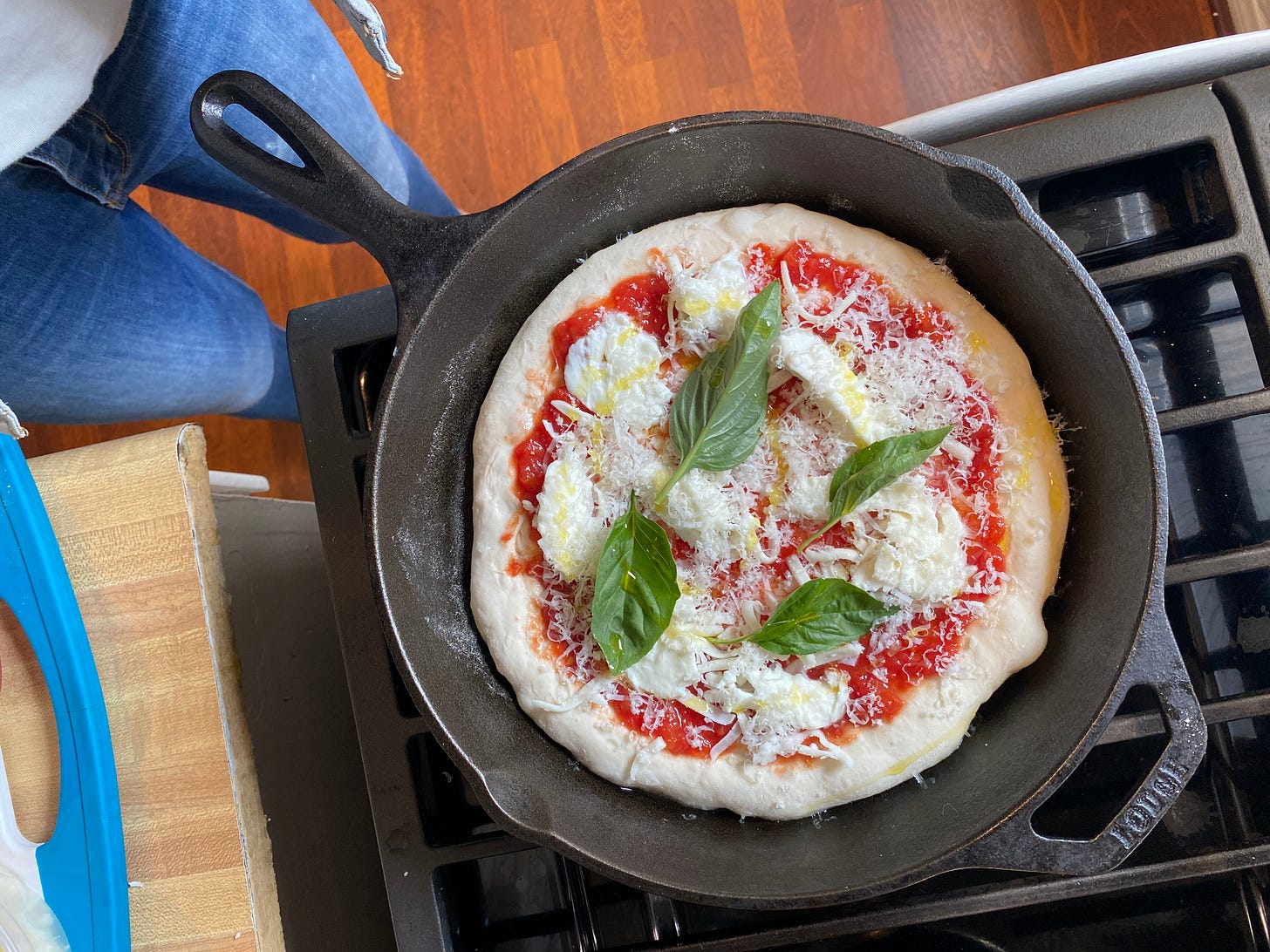Dearest Pizza Tourists, HNY! Whether or not you believe in New Year's resolutions, starting out the year with a mind hungry to learn something new is never a bad idea. While I know you eat pizza, have you tried your hand at making it? Well, maybe this is your year to dial in that skill.
At the start of every month, I’m going to create a list of pizza pantry favorites that include something seasonal, or, a fun new product I’ve been testing on my pizza pies. To kick off January, we’ll start with your most basic pizza pantry 101. Any pizza maker will tell you that a good pizza starts with good ingredients.
I’m going to start you off with one of my favorite yeasted pizza dough recipes. Yes you can dive into the world of sourdough, longer fermentations, and greater hydrations – but I feel that starting with a yeasted recipe you’ll be more likely to keep making it, which is crucial in learning a from-scratch recipe like this. And remember if you have these items in your pantry, you can make a pretty darn tasty pizza wherever and whoever you are.
YOUR PIZZA PANTRY 101
Cooking EVOO (Extra Virgin Olive Oil) If you keep up with the olive oil world, you know that it’s always been somewhat of a controversial subject. It’s very hard to keep track of companies adulterating their extra virgin olive oils with lower quality oils and false flavoring. Do I have an all-time favorite olive oil I like to use? Not really. But this year I’ll make it my mission to really explore and have an official opinion on the matter. For starters, I thought the Tik Tok from America’s Test Kitchen had an interesting tik take on the “Instagram-Famous Olive Oils”.
Finishing EVOO When I first started working as a line cook in Los Angeles, one thing I first noticed was how most dishes were finished with a flakey sea salt and drizzle of good olive oil. These finishing touches really do elevate a dish. Many trustable chefs I know love the Olio Verde Extra Virgin Olive Oil. Next time you have an opportunity, try tasting some nicer olive oils and figure out what you like. Consider the levels of fruitiness, bitterness, and pungency. Is it too overpowering? How does it compare to other olive oils?
Sea Salt I like to keep a few bottles of La Baleine Fine Sea Salt in my pantry as my seasoning salt. Good in your dough recipe or for flavoring sauces, etc. If you can’t find it, Diamond Crystal Kosher is a great substitute.
Flakey Salt Your finishing salt. You can buy a big gorgeous bucket of Maldon and keep in a smaller beautiful spice jar on your counter. See my note on Olive #2. While I have yet to read it, a few of my salt friend aficionados recommend the book “Salt: A World History”.
Tomato Cans Contrary to popular belief, you don’t need San Marzano tomatoes to make a good pizza. Rumor has it that the infamous San Marzano tomato seed actually came from Peru. Back in 1770 the Viceroyalty of Peru brought the tomato seeds as a gift to the Kingdom of Naples. What do I use? I always like to keep a few of the yellow Bianco Di Napoli cans on hand. Bianco Di Napoli is a collaboration between pizza mogul Chris Bianco and tomato legend Rob Di Napoli. I can say first hand that they both have hearts of gold and together have paved the way for Artisan pizza in the USA. I particularly like the organic yellow can of whole tomatoes so you can crush the tomatoes with your bare hands to the desired consistency. Do you like to taste chunks of tomato in your sauce for texture? Or have a smoother and even consistency. Something important to think about for your pizza personality. If I’m not buying Bianco Di Napoli, I’ll have fun in Italian grocery stores and buy different varieties of tomatoes like those from Sardinia or Sicily.
Hot Honey There is a lot of good hot honey out there. And it’s pretty easy to make your own! One of my Los Angeles favorites is Zab’s honey. And for us dog lovers, the company is named after their dog! While hot honey and meat go together like milk and cookies, honey is also a killer with plain bianco cheese…or pour it all over your crust.
Pepperoni My favorite is the pork cupping pepperoni that Ezzo makes – harder to find in retail stores but I believe Surfas sells it if you are local in LA. Don’t eat pork? I’ll often use the Applegate Turkey Pepperoni for clients and although I am turkey-skeptical, it's actually pretty good.'
Hunk of Parmigiano Reggiano Go for a nice hunk of Parmigiano Reggiano rather than the pre-shredded stuff. Pre-shredded cheeses often use caking agents that interfere with the taste and texture of the cheese. I like to use a microplane and shave a fresh hunk over pizza. This also provides a little bit of good showmanship for whomever is watching you make the pizza. The taste profile of Parmigiano Reggiano is nutty and slightly sweet.
Crumbled pecorino Same note for Pecorino. But I would crumble this by sticking smaller chunks of pecorino in a kitchen aid. It will crumble the Pecorino into smaller pieces. There are many different varieties of Pecorino but the famous pizza cheese is Pecorino Romano. The taste profile of Pecorino is salty and grassy.
Mozzarella: Fresh and Dry Maybe it’s US regulations but this is something that I think the Italians are just generally better at. If you have a local distributor and want to invest in the imported, you can’t go wrong. For US brands, BelGioioso is pretty consistent with a decent flavor profile. For dry I like using Grande (only available wholesale) or Polly-O – which many New York pizzerias swear by. To age your dry mozzarella, vacuum seal it. It should extend further past its “expiration date” and provide a tangier flavor. If it smells bad, throw it out.
Magic Pizza Dust Our signature finishing salt! You’ve probably seen me use it in videos. We are working on a rebrand so stay tuned.
Basil It’s winter time so it’s probably not easy to get an abundance of fresh basil. If you have a window ledge, try growing a small plant in a sunny window. If your basil is looking mangy just throw it in the sauce to cook. If it’s fresh and beautiful, top your pizza with the prized leaves. Sometimes it’s nice to do both. As Noel Brohner, my wise pizza friend, likes to say, “Pizza is not a condiment.” So use as much of anything as you’d like on your pizza creation.
00 Flour Caputo pizza flour is probably the easiest to find flour at your local Italian grocery store. Not anywhere near an Italian deli? Order it online. What is 00 flour? It’s a finer-milled “soft wheat” flour with a higher protein content. Caputo 00 is about 13% protein content which allows for stronger gluten which means more chew, more stretch. There are better 00 flours out there, and also US varieties, but I find Caputo to be the most consistent especially when starting out. Fun fact I learned in pizza school – did you know that most Italian flours are actually grown in Canada? They are milled and packaged in Italy but sent worldwide. Food for thought when ordering your “well-traveled” flour.
Instant Dried Yeast If you are good at maintaining a sourdough starter then by all means it’s always nice to have a readily available “live” jar in your fridge for use as a leavening. But if you travel or find yourself preoccupied by other life things, it’s good to keep some instant dry yeast in your pantry to make pizza dough in a pinch. Saf-Instant or Fleischmann’s are both good brands and should be available in most grocery stores. Keep yeast in your fridge for a longer shelf life. The yeast will usually last about a year, so keep the expiration date on the jar if you repackage it.
Stretching Flour Semolina, rice flour, or 00. Rice flour is definitely the most expensive of all the stretching flours. But I feel like it provides the nicest flavoring and doesn’t burn as easily as Semolina or 00 flour. However, all three of these work. Some find it nice to do a blend. Remember that you want to use enough flour to “handle” the dough but not too much so that it will burn and turn bitter in the oven. Remember to shake as much off as you can before launching your pizza into the oven.
Pizza Dough Recipe:
Ingredients:
1000G 00 Flour








